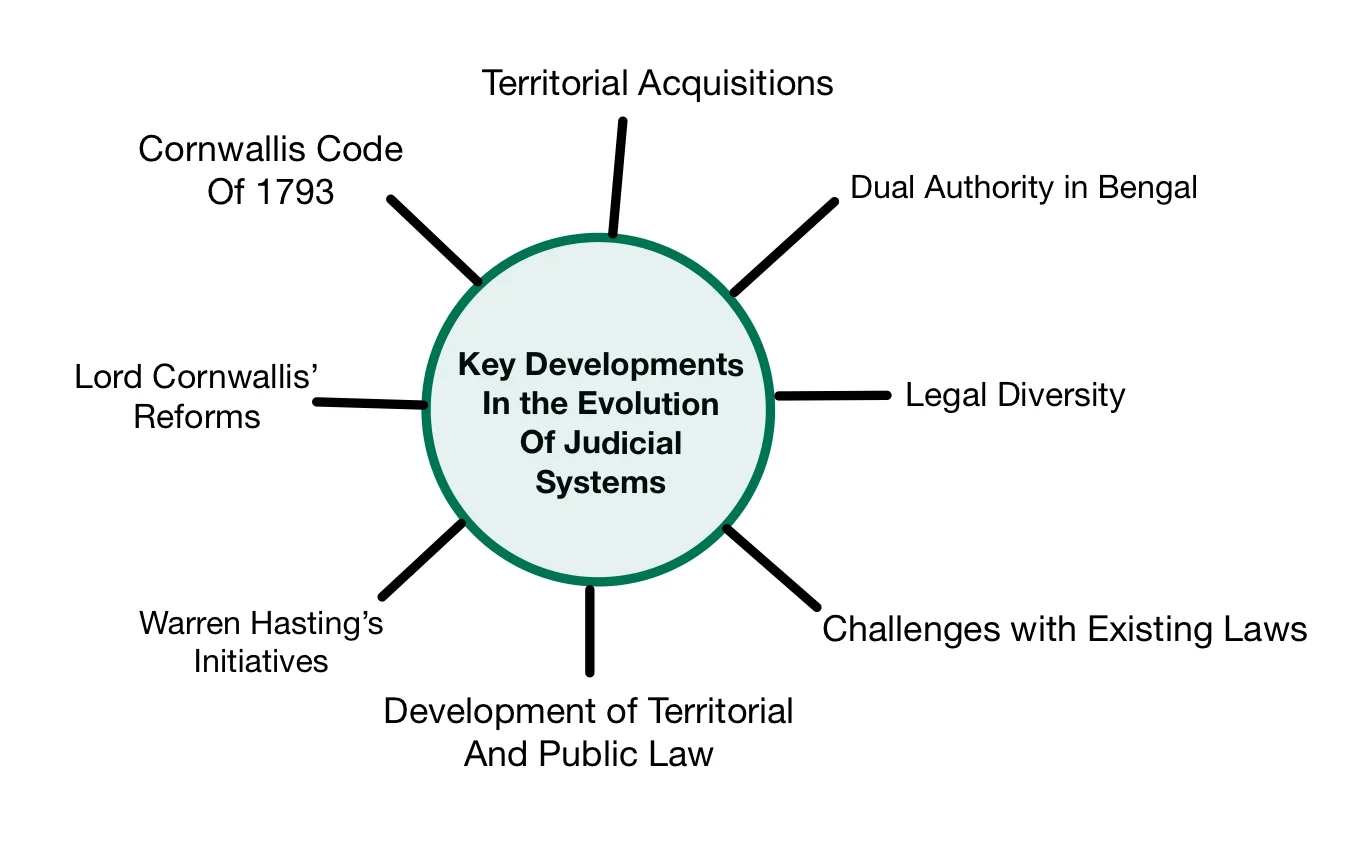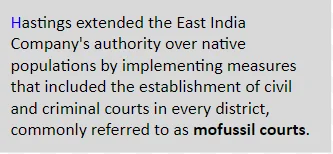In pre-colonial India, during the Mughal era and even earlier in ancient times, the judicial system lacked established procedures, a structured organization of law courts, and a systematic distribution of courts according to the region’s size. Most legal matters among Hindus were resolved by caste elders, village panchayats, or local zamindars. Muslims relied on the qazi, typically a religious authority, situated in provincial capitals, towns, and larger villages. The kings and emperors were viewed as the ultimate sources of justice, and the process of delivering justice often appeared arbitrary.
Foundation of Common Law in British India
Role of Mayor’s Courts: The introduction of a common law system, which relied on recorded judicial precedents, can be traced back to the establishment of ‘Mayor’s Courts’ in Madras, Bombay, and Calcutta by the East India Company in 1726.
- Judicial Powers of the East India Company: EIC had been authorised to execute judicial powers in India by the Charter of 1662.
- The Charter of 1726 had empowered EIC to establish Mayor’s courts (Courts of the King of England) in Calcutta, Bombay, and Madras, however, it was silent over the Company’s jurisdiction over natives.
- As the East India Company evolved from a trading entity into a ruling authority, it replaced the existing Mughal legal system with new elements in the judicial system.
Enroll now for UPSC Online Course
Factors That Led to the Evolution of the Judicial System
The establishment and reorganization of the judicial system by the English East India Company in India was a complex process influenced by various territorial acquisitions and local judicial traditions. Here is an overview of the key developments and elements in the evolution of the British judicial system in India:

- Territorial Acquisitions: The English East India Company acquired different territories in India through various means, including cession and grants from local rulers.
- These acquisitions had distinct legal and administrative implications.
- Dual Authority in Bengal: In Bengal, the Company received the Diwani of Bengal, Bihar, and Orissa from Emperor Shah Alam II in 1765.
- The Diwani functions included civil administration and civil justice.
- However, the Nizamat functions, which pertained to maintaining law and order and administering criminal justice, were retained by the Nawab of Bengal.
- Legal Diversity: Before British rule, India had a diverse judicial system based on Hindu and Muslim laws, supplemented by customary laws and the authority of the ruling power in various regions.
- The European merchant companies, including the English East India Company, encountered this diversity.
- Challenges with Existing Laws: The European companies found it challenging to accept certain aspects of the existing legal systems, such as the Muslim criminal law’s harsh penalties, including amputation and stoning, and the preferential treatment of certain religious or caste groups.
- Development of Territorial and Public Law: The rise of national states in Europe has led to the development of concepts of territorial and public law.
- European merchant companies needed a more unified legal system to govern the territories under their control.
- Warren Hastings’ Initiatives: Warren Hastings played a pivotal role in organising a basic framework for the judicial system. He established Diwani and Faujdari Adalats at the district level.
- Appeals from these adalats could be made to the Sadar Diwani Adalat and Sadar Nizamat Adalat in Calcutta.
- Lord Cornwallis’ Reforms: Lord Cornwallis further improved and expanded the judicial system. He introduced a hierarchy of courts for both civil and criminal cases, setting up Munsiff’s Courts, Registrars’ Courts, District or City Courts, Provincial Courts, and Sadar Diwani and Sadar Nizamat Adalats.
- These courts had specified jurisdictions and functions.
- Cornwallis Code of 1793: The Cornwallis Code, promulgated in 1793, provided the final shape to the judicial system.
- This code established the principles and structures that continued to govern the legal system in India for a significant period.
Judicial Reforms Under Various Governor Generals
The evolution of the British judicial system in India involved a gradual transition from diverse local legal traditions to a more unified, hierarchical system. The changes brought about by Warren Hastings and Lord Cornwallis laid the foundation for the subsequent development of the Indian legal system.
Judicial Reforms under Warren Hastings (1772-1785)

Reforms introduced during Warren Hastings’ administration (1772-1785) included:
- Establishment of District Diwani Adalats: These courts were created in districts to handle civil disputes. The Diwani Adalat, presided over by the Collector, had jurisdiction over civil cases, including matters related to personal property, inheritance, caste, marriage, and debts.
- Hindu law applied to cases involving Hindus, and Muslim law applied to cases involving Muslims.
- Appeals from District Diwani Adalats were directed to the Sadar Diwani Adalat, which operated under the guidance of a president and two members of the Supreme Council.

- Formation of District Faujdari Adalats: These courts were established to address criminal disputes and were overseen by Indian officers, with the assistance of qazis and muftis. The collector provided general supervision.
- Muslim law was applied in Faujdari Adalats.
- Decisions involving capital punishment and property acquisition were subject to approval from the Sadar Nizamat Adalat in Murshidabad.
- This higher court was headed by a deputy nizam, an Indian Muslim, and assisted by the chief qazi and chief mufti.
- Creation of the Supreme Court under the Regulating Act of 1773: A Supreme Court was established in Calcutta with the authority to hear cases involving all British subjects within Calcutta and its subordinate factories, encompassing both Indians and Europeans.
- The Supreme Court had both original and appellate jurisdictions.
- However, conflicts occasionally arose between the Supreme Court’s jurisdiction and that of other existing courts.
- The Supreme Court had both original and appellate jurisdictions.
Enroll now for UPSC Online Course
To alleviate these tensions and avoid conflicts between the Supreme Court and the Sadar Diwani Adalat and Sadr Nizamat Adalat, Warren Hastings appointed Sir Elijah Impey (13 June 1732 – 1 October 1809), Chief Justice of the Supreme Court, as the Superintendent of Sadr Diwani Adalat in 1780. However, this appointment was disallowed by the Court of Directors, and Elijah Impey had to resign in 1782. Consequently, the dualism in the legal system persisted throughout the East India Company’s rule in India.
| Must Read | |
| Current Affairs | Editorial Analysis |
| Upsc Notes | Upsc Blogs |
| NCERT Notes | Free Main Answer Writing |
Conclusion
The development of the judiciary in pre-Cornwallis India was marked by the gradual evolution from diverse, localized legal systems to a more structured, unified judiciary under British rule. Influenced by figures like Warren Hastings and Lord Cornwallis, reforms established a hierarchy of courts and introduced key legal codes, laying the groundwork for modern India’s legal system. This transition from traditional law to a more codified system reshaped justice administration in colonial India.
Sign up for the PWOnlyIAS Online Course by Physics Wallah and start your journey to IAS success today!

 GS Foundation
GS Foundation Optional Course
Optional Course Combo Courses
Combo Courses Degree Program
Degree Program









